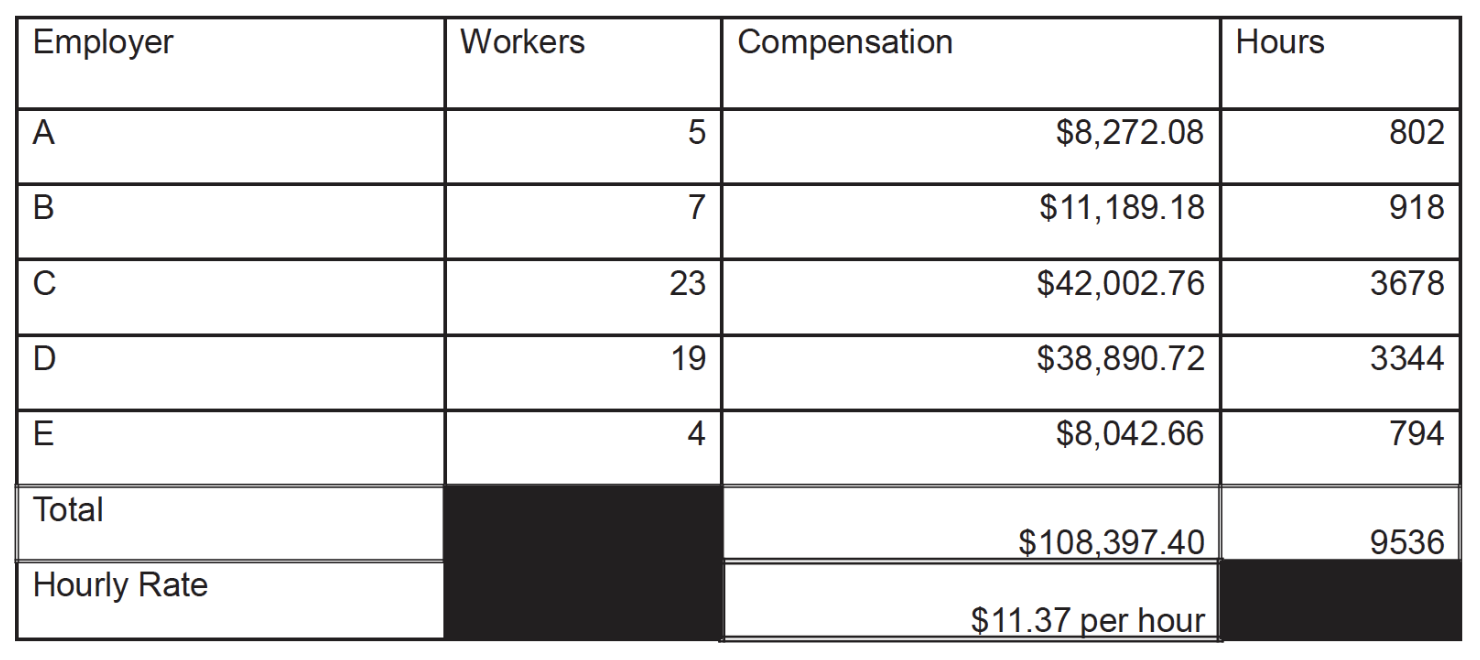H-2A Agriculture Program
Wage Setting Requirements
Hourly Adverse Effect Wage Rates (AEWR)
- Based on U.S. Department of Agriculture’s (USDA) Farm Labor Survey
- Annual weighted average hourly wage for field and livestock workers (combined)
- Wage rates are statewide based on USDA regions
- For current AEWRs, visit the OFLC Agricultural Online Wage Library at:
https://www.foreignlaborcert.doleta.gov/adverse.cfm
Prevailing Wage
- The wage (hourly, weekly) determined by the SWA to be prevailing in the local, regional, or statewide area
Prevailing Piece Rate
- The amount that is paid to workers in the crop or commodity per piece (e.g., bin, pallet, bushel) determined by the SWA to be prevailing in the local, regional, or statewide area
- For current prevailing wages, visit the OFLC Agricultural Online Wage Library at: http://www.foreignlaborcert.doleta.gov/aowl.cfm
Questions about minimum wage requirements should be directed to the SWA at the time of placing the job order.
- If the USDA hourly AEWR and/or the SWA prevailing wage or piece rate is adjusted during a work contract period and is now the highest applicable minimum wage in effect at the time work is performed, the employer must pay that higher wage
Important Reminders:
- Annual updates to the USDA hourly AEWRs are published in the Federal Register some time during the month of December
- Remember that the monthly AEWR for occupations involved in the herding or production of livestock will also be published in the Federal Register in December and become effective January 1, 2016
Make sure wage offer(s) match the Form ETA-9142A in each of the crops and commodities

H-2B Non-Agriculture Program
Wage Setting Requirements
General Filing Tips
- DO NOT WAIT! Please file your request for a prevailing wage determination as soon as practically possible
- As of July 1, 2016, the validity period for prevailing wage determinations will be issued to June 30, 2017
- Under the 2016 DOL Appropriations Act, the term “private survey” include (1) government surveys not conducted or issued by DOL, and (2) non-government surveys conducted by private individuals or organizations who are bona fide third parties
- Employer-provided surveys must provide the single arithmetic mean of wages paid to all workers in the occupational classification within the area of intended employment, regardless of skill level, experience, education, and length of employment
Reminder: Where the survey provides only a median, not an arithmetic mean, a median wage is acceptable
Job Descriptions: Be Thorough, Yet Concise
- DO be concise, but adequately thorough to avoid RFI and expedite processing.
- DON’T include information unrelated to job duties and unnecessary to determine the skill, knowledge, and experience requirements for the job.
- Do not include statements about lodging
- Do not restate the legal requirements outlined in the regulation
- Just because something is needed for advertising does not mean it has to be in the PWD job duties
- DO include relevant facts about the nature and extent of each duty
- Descriptions of the size/scope of trenching work must be sufficient to permit a determination of whether the work is hazardous.
- Descriptions of food preparation/handling duties must be sufficient to permit a determination of the type of food and whether the worker cooks and/or serves the food. For example:
- Cook hamburgers, French fries and chicken patties using a repetitive process
- Cook menu items according to recipe
- Assemble sandwiches and serve to customer at counter
- Serve premade foods/beverages to customers at counter and accept payment
- What and where loading/unloading of products or commodities is occurring. For example:
- Unload bags of crawfish from truck
- Unload finished table legs from lathe
- Load boxes of shingles onto pallet then onto the warehouse shelves using a forklift
Survey Samples: Survey the Necessary Area
- DO survey all, or a randomized sample of all, employers of workers within the entire Area of Intended Employment (AIE)
- AIE = Area within normal commuting distance of the place of employment. Includes any place within the Metropolitan Statistical Area (MSA) encompassing the worksite. Locations outside the MSA may be included if they and the worksite are near the MSA border. 20 CFR 655.3
- DON’T expand the surveyed area beyond the AIE without explaining necessity (must be in survey documents)
- Area may be expanded if insufficient # of employers (less than 3)
- OR insufficient # workers (<30) in the occupation, are available in the AIE
- DO describe the extent of expansion and explain that the expansion was (must be in survey documents):
- No greater than necessary to meet the 30 worker/3 employer sample size requirement
- Limited to areas contiguous with (immediately surrounding) the AIE (“Incremental, tailored expansion”)
Survey Samples: Describe the Wage Sample
- DO include all required types of pay in the wage sample
- Required Types = Base rate, piece rate, production bonus, tips, incentive pay, and several others listed in the ETA-9165 instructions
- Reported as an hourly rate
- DO describe the method used to convert piece rate/bonus pay to hourly survey wage
- An easy way to meet the wage sample requirements is to use the Total Compensation Method
- All types of pay (e.g., base, piece, tips) for all workers divided by hours worked by all workers to earn that compensation.

Form ETA-9165: Avoid Common Errors
- DON’T confuse the universe size with the sample size
- The universe is the number of firms employing workers and may be an estimate.
- The sample size is the number of employers asked to provide information and is a subset of the universe

- DO ensure you have listed the correct AIE surveyed in Field D.3, Form ETA-9165
- List the counties within normal commuting distance from the work address
- It is acceptable to list the MSA where the
worksite(s) is located in a MSA since any place within the MSA is deemed
by the regulation to be within normal commuting distance of the place
of intended employment
